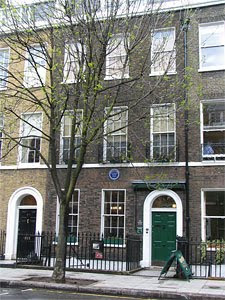 Our class was scheduled to visit the British Museum Archives today. However, as there were not enough spots for all of us, some of us went on an alternate itinerary. Karen Rowell took us on a brief tour of the British Museum and then to the Charles Dickens Museum before heading back to visit the British Museum Library. The Dickens Museum is located in the house where Dickens lived from 1837-1839, and is a rather modest four floors full of papers, copies of his books, and room reconstructions. They had on an Oliver Twist exhibition that had costumes from the musical and displays. My favourite piece was a reading copy of of Sikes and Nancy (from Oliver Twist) with Dickens' handwritten stage directions. The Museum also included a lovely rear garden.
Our class was scheduled to visit the British Museum Archives today. However, as there were not enough spots for all of us, some of us went on an alternate itinerary. Karen Rowell took us on a brief tour of the British Museum and then to the Charles Dickens Museum before heading back to visit the British Museum Library. The Dickens Museum is located in the house where Dickens lived from 1837-1839, and is a rather modest four floors full of papers, copies of his books, and room reconstructions. They had on an Oliver Twist exhibition that had costumes from the musical and displays. My favourite piece was a reading copy of of Sikes and Nancy (from Oliver Twist) with Dickens' handwritten stage directions. The Museum also included a lovely rear garden. After touring the Dickens Museum, we returned to the British Museum where we were given a guided tour of the public library by the librarian, Charles Hoare. We first learned about the history of the British Museum libraries. The first library was founded in 1753, but it was not until the 1840s that a portion of what is now the British Museum was built. In 1973 the library collections were split into different collections and in 1997 most of them moved to the new British Library building.
 The Museum has many different libraries, including the public library and curatorial department libraries. The public library is named the Paul Hamlyn Library and its materials are available for members of the public to browse, but not to check-out. Its collection consists of about 16,000 books and over 50 journals, catalogued in accordance with the Dewey Decimal System. Most of these books are in English (the curatorial departments have more foreign language materials). Mr. Hoare took us on a special behind the scenes tour to show us materials not on public display. We strolled through the Enlightenment Gallery and were delighted to go through a secret doorway to the back area that was masquerading as shelves of books. The back area contained back issues of journals, rare books, and the literature and history collections (there is not enough room in the main library to house all of the regular collection). In addition, we were able to see posters of past Museum exhibitions dating back to the 1930s.
The Museum has many different libraries, including the public library and curatorial department libraries. The public library is named the Paul Hamlyn Library and its materials are available for members of the public to browse, but not to check-out. Its collection consists of about 16,000 books and over 50 journals, catalogued in accordance with the Dewey Decimal System. Most of these books are in English (the curatorial departments have more foreign language materials). Mr. Hoare took us on a special behind the scenes tour to show us materials not on public display. We strolled through the Enlightenment Gallery and were delighted to go through a secret doorway to the back area that was masquerading as shelves of books. The back area contained back issues of journals, rare books, and the literature and history collections (there is not enough room in the main library to house all of the regular collection). In addition, we were able to see posters of past Museum exhibitions dating back to the 1930s.My favorite part of the public library was the small children's area. It included a children's play area with small cushioned seats and crayons for coloring. The Library also offers resources for teachers, booklists, seven different children's information sets, and family backpacks that are tailored to different parts of the Museum.
Photos courtesy of the Charles Dickens Museum (take the virtual tour!) and Carpe Londinium (British Museum).
Photos courtesy of the Charles Dickens Museum (take the virtual tour!) and Carpe Londinium (British Museum).
No comments:
Post a Comment